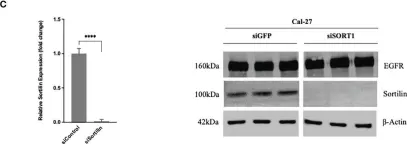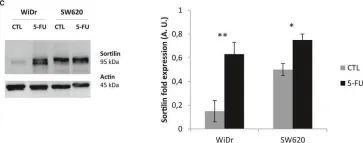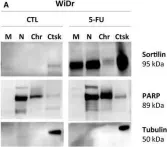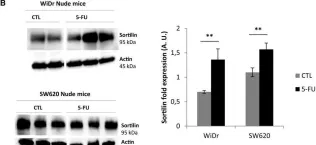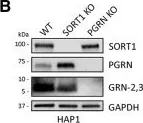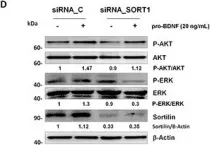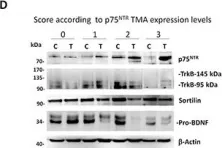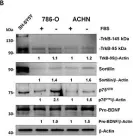A subset of neuroendocrine tumors (NETs) can cause an excessive secretion of hormones, neuropeptides, and biogenic amines into the bloodstream. These so-called functional NETs evoke a hormone-related disease and lead to several different syndromes, depending on the factors released. One of the most common functional syndromes, carcinoid syndrome, is characterized mainly by over-secretion of serotonin. However, what distinguishes functional from non-functional tumors on a molecular level remains unknown. Here, we demonstrate that the expression of sortilin, a widely expressed transmembrane receptor involved in intracellular protein sorting, is significantly increased in functional compared to non-functional NETs and thus can be used as a biomarker for functional NETs. Furthermore, using a cell line model of functional NETs, as well as organoids, we demonstrate that inhibition of sortilin reduces cellular serotonin concentrations and may therefore serve as a novel therapeutic target to treat patients with carcinoid syndrome.
Copyright © 2024 Bolduan, Wetzel, Giesecke, Eichhorn, Alenina, Bader, Willnow, Wiedenmann and Sigal.
Product Citations: 14
In Frontiers in Endocrinology on 2 May 2024 by Bolduan, F., Wetzel, A., et al.
-
WB
-
Homo sapiens (Human)
-
Cancer Research
-
Endocrinology and Physiology
In Frontiers in Oncology on 14 August 2023 by Morisse, M., Bourhis, T., et al.
Head and Neck Squamous Cell Carcinoma (HNSCC) remains a cancer with a poor prognosis, with a 5-year survival rate of less than 50%. Although epidermal growth factor receptor (EGFR) is almost always overexpressed, targeted anti-EGFR therapies have modest efficacy and are mainly used in palliative care. Growth factors such as Nerve Growth Factor (NGF) and its precursor proNGF have been shown in our laboratory to play a role in tumor growth and aggressiveness. Interestingly, an interaction between Sortilin, a proNGF receptor, and EGFR has been observed. This interaction appears to interfere with the pro-oncogenic signaling of EGF and modulate the membrane expression of EGFR. The aim of this study was to characterize this interaction biologically, to assess its impact on clinical prognosis and to analyze its role in the cellular trafficking of EGFR. Using immunohistochemical staining on tumor sections from patients treated at our university center and PLA (Proximity Ligation Assay) labeling, we showed that Sortilin expression is significantly associated with reduced 5-year survival. However, when Sortilin was associated with EGFR, this association was not found. Using the Cal-27 and Cal-33 cancer cell lines, we observed that proNGF reduces the effects of EGF on cell growth by inducing the internalization of its receptor. These results therefore suggest a regulatory role for Sortilin in the degradation or renewal of EGFR on the membrane. It would be interesting in future work to show the intracellular fate of EGFR and the role of (pro)neurotrophins in these mechanisms.
Copyright © 2023 Morisse, Bourhis, Lévêque, Guilbert, Cicero, Palma, Chevalier, le Bourhis, Toillon and Mouawad.
-
WB
-
Homo sapiens (Human)
-
Cancer Research
In Journal of Cell Science on 15 October 2021 by Asaro, A., Sinha, R., et al.
Sortilin is a neuronal receptor for apolipoprotein E (apoE). Sortilin-dependent uptake of lipidated apoE promotes conversion of polyunsaturated fatty acids (PUFA) into neuromodulators that induce anti-inflammatory gene expression in the brain. This neuroprotective pathway works with the apoE3 variant but is lost with the apoE4 variant, the main risk factor for Alzheimer's disease (AD). Here, we elucidated steps in cellular handling of lipids through sortilin, and why they are disrupted by apoE4. Combining unbiased proteome screens with analyses in mouse models, we uncover interaction of sortilin with fatty acid-binding protein 7 (FABP7), the intracellular carrier for PUFA in the brain. In the presence of apoE3, sortilin promotes functional expression of FABP7 and its ability to elicit lipid-dependent gene transcription. By contrast, apoE4 binding blocks sortilin-mediated sorting, causing catabolism of FABP7 and impairing lipid signaling. Reduced FABP7 levels in the brain of AD patients expressing apoE4 substantiate the relevance of these interactions for neuronal lipid homeostasis. Taken together, we document interaction of sortilin with mediators of extracellular and intracellular lipid transport that provides a mechanistic explanation for loss of a neuroprotective lipid metabolism in AD.
© 2021. Published by The Company of Biologists Ltd.
-
Cell Biology
CHIP-dependent regulation of the actin cytoskeleton is linked to neuronal cell membrane integrity.
In IScience on 20 August 2021 by Dias, C., Nita, E., et al.
CHIP is an E3-ubiquitin ligase that contributes to healthy aging and has been characterized as neuroprotective. To elucidate dominant CHIP-dependent changes in protein steady-state levels in a patient-derived human neuronal model, CHIP function was ablated using gene-editing and an unbiased proteomic analysis conducted to compare knock-out and wild-type isogenic induced pluripotent stem cell (iPSC)-derived cortical neurons. Rather than a broad effect on protein homeostasis, loss of CHIP function impacted on a focused cohort of proteins from actin cytoskeleton signaling and membrane integrity networks. In support of the proteomics, CHIP knockout cells had enhanced sensitivity to induced membrane damage. We conclude that the major readout of CHIP function in cortical neurons derived from iPSC of a patient with elevate α-synuclein, Parkinson's disease and dementia, is the modulation of substrates involved in maintaining cellular "health". Thus, regulation of the actin cytoskeletal and membrane integrity likely contributes to the neuroprotective function(s) of CHIP.
© 2021 The Authors.
-
Homo sapiens (Human)
-
Cell Biology
In Journal of Cellular and Molecular Medicine on 1 January 2021 by Blondy, S., Talbot, H., et al.
Colorectal cancer (CRC) is the third most common cancer worldwide. Even if 5-fluorouracil (5-FU) is used as the first-line chemotherapeutic drug, responsiveness is only 20-30%. Acquired resistance to 5-FU contributes to both poor patient prognosis and relapse, emphasizing the need to identify biomarkers. Sortilin, a vacuolar protein sorting 10 protein (Vps10p), implicated in protein trafficking, is over expressed in CRC cell lines cultured 72 hours in presence of 5-FU. This overexpression was also observed in 5-FU-resistant cells derived from these cell lines as well as in CRC primary cultures (or patients derived cell lines). A significantly higher expression of sortilin was observed in vivo, in 5-FU-treated tumours engrafted in Nude mice, as compared with non-treated tumour. A study of transcriptional regulation allowed identifying a decrease in ATF3 expression, as an explanation of sortilin overexpression following 5-FU treatment. In silico analysis revealed SORT1 expression correlation with poor prognosis. Moreover, sortilin expression was found to be positively correlated with CRC tumour grades. Collectively, our findings identify sortilin as a potential biomarker of 5-FU resistance associated with poor clinical outcomes and aggressiveness in CRC. As a new prognostic factor, sortilin expression could be used to fight against CRC.
© 2020 The Authors. Journal of Cellular and Molecular Medicine published by Foundation for Cellular and Molecular Medicine and John Wiley & Sons Ltd.
-
WB
-
IF
-
Biochemistry and Molecular biology
-
Cancer Research
In Front Oncol on 14 August 2023 by Morisse, M., Bourhis, T., et al.
Fig.3.C

-
WB
-
Homo sapiens (Human)
Collected and cropped from Front Oncol by CiteAb, provided under a CC-BY license
Image 1 of 9
In J Cell Mol Med on 1 January 2021 by Blondy, S., Talbot, H., et al.
Fig.1.C

-
WB
-
Collected and cropped from J Cell Mol Med by CiteAb, provided under a CC-BY license
Image 1 of 9
In J Cell Mol Med on 1 January 2021 by Blondy, S., Talbot, H., et al.
Fig.2.C

-
WB
-
Collected and cropped from J Cell Mol Med by CiteAb, provided under a CC-BY license
Image 1 of 9
In J Cell Mol Med on 1 January 2021 by Blondy, S., Talbot, H., et al.
Fig.3.A

-
WB
-
Collected and cropped from J Cell Mol Med by CiteAb, provided under a CC-BY license
Image 1 of 9
In J Cell Mol Med on 1 January 2021 by Blondy, S., Talbot, H., et al.
Fig.4.B

-
WB
-
Collected and cropped from J Cell Mol Med by CiteAb, provided under a CC-BY license
Image 1 of 9
In Eneuro on 23 August 2017 by Holler, C. J., Taylor, G., et al.
Fig.6.B

-
WB
-
Homo sapiens (Human)
Collected and cropped from Eneuro by CiteAb, provided under a CC-BY license
Image 1 of 9
In Oncotarget on 7 June 2016 by de la Cruz-Morcillo, M. A., Berger, J., et al.
Fig.7.D

-
WB
-
Homo sapiens (Human)
Collected and cropped from Oncotarget by CiteAb, provided under a CC-BY license
Image 1 of 9
In Oncotarget on 7 June 2016 by de la Cruz-Morcillo, M. A., Berger, J., et al.
Fig.2.D

-
WB
-
Collected and cropped from Oncotarget by CiteAb, provided under a CC-BY license
Image 1 of 9
In Oncotarget on 7 June 2016 by de la Cruz-Morcillo, M. A., Berger, J., et al.
Fig.3.B

-
WB
-
Collected and cropped from Oncotarget by CiteAb, provided under a CC-BY license
Image 1 of 9
